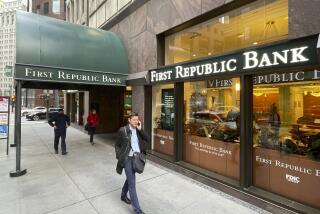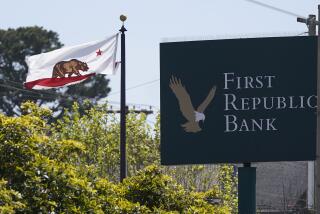U.S. plan to purchase toxic bank assets raising alarms
- Share via
LOS ANGELES AND WASHINGTON — The Obama administration’s impending effort to buy about $1 trillion in toxic assets in partnership with private investors -- aimed at solving the most intractable part of the credit crisis -- is now generating widespread fear that it is vulnerable to manipulation and carries sharp risks for taxpayers.
The program represents the biggest gamble yet in the federal bailout, but its still-hazy details have prompted bankers, economists, federal investigators and politicians to question whether it will solve the financial crisis. More than 400 written comments were recently submitted to the Treasury Department, many of them sharply negative.
The program is trying to create an artificial market for assets that have no known value, something that has never been done before on this scale. The only way to accomplish that is for the government to accept a mountain of risk.
In the process, critics fear that the banking system could be further damaged and the program subjected to a boom in fraud.
Nobel Prize-winning economist Joseph Stiglitz of Columbia University said the program violated so many laws of economics that it was little more than an “empty box.”
The toxic assets are a multitrillion-dollar collection of mortgage loans, commercial loans and a variety of complex debt securities, in which many borrowers have stopped making payments and the value of the underlying properties have tumbled. There is so much uncertainty about the value of those loans -- held both by banks and by big institutional investors -- that they have become a black hole in the financial system.
Critics say the government’s effort to engineer a solution is creating risks similar to the ones that created the financial crisis in the first place.
“We are repeating all the mistakes that the mortgage guys made,” Stiglitz said. “In the worst case, the national debt goes up by $1 trillion.”
Supporters of the program say that the economy would face bigger risks if nothing is done to solve the problem. The program, they say, represents a bold move by the government to unfreeze the financial markets. In the process, taxpayers could reap multibillion-dollar profits from the partnerships.
Indeed, when the program was unveiled one month ago, it was met by such euphoria that the Dow Jones industrial average shot up 500 points in a day.
The program, called the Public-Private Investment Program, is still being formed and basic answers about how it will work are being hammered out by officials at the Treasury Department, the Federal Deposit Insurance Corp. and the Federal Reserve.
The goal of the program is to create a market for the toxic assets that are now clogging the system. They sit on balance sheets, tying up funds and obscuring the condition of financial institutions.
The loans and debt securities are not worthless. In some cases, individual loans within complex bundles have not gone bad. And even in the cases of loans that have gone bad, the underlying homes or other assets still have some value. But because nobody knows how to value these loans and debt securities, nobody is willing to trade them.
If the program can help set prices for those assets and create markets for their sale, banks will more quickly regain healthy balance sheets and financial markets that trade in debt securities will regain their footing.
The government hopes to jump-start a market. Private investors would be enticed to join and, by competing against one another, finally set a price for the assets.
The Bush administration last fall had planned to simply buy all the toxic assets on its own, but there were concerns that it would end up overpaying and it didn’t have enough money. With private investors involved, there is the hope that their competition and desire for profit will ensure that prices aren’t set too high.
The government does not have to buy every bad asset, Treasury officials said, but simply get enough activity going so that buyers and sellers could begin to set prices on their own.
There are two separate pieces to the program -- one operated by the FDIC to auction bundles of troubled bank loans and another operated by the Treasury Department to buy securities without auctions from hedge funds, investment firms and others.
The money to operate these programs is coming from the $750-billion Troubled Asset Relief Program that was enacted last fall, along with additional lending by the Federal Reserve.
Under the Treasury plan, five so-called fund managers would raise a pool of private money, matched equally by the government. Then, the Fed would double that pool with loans or loan guarantees. Thus, the government would be putting up 75% of all the money.
The fund managers would negotiate to buy the toxic securities based on an analysis of the investments and a bit of educated guessing.
The FDIC program would rely on even more government-backed debt. A variety of partnership funds would be created with private investors kicking in 7.5% of the money and the government providing a matching 7.5%. The government would then provide the remaining 85% in loans or loan guarantees.
The partnerships would bid against one another in an auction.
Although the two plans address different parts of the credit crisis and use different methods, critics see many of the same vulnerabilities.
Stiglitz, along with others, believes the market will be far from perfect. Since the government is putting in so much more money, it would lead private investors to take on riskier investments. And the burden of that increased risk would fall almost entirely on the government, even though the government would share only half the potential profit.
The FDIC has said that if it faces too many defaults, it may have to assess new fees -- which are already increasing -- on the entire banking industry, a scary prospect for smaller banks.
Although the FDIC has downplayed the risk of such defaults, other experts are not so sure.
“We are in an economic climate that is still filled with a tremendous amount of uncertainty,” said Rodney K. Brown, the president of the California Bankers Assn.
Brown said if the Treasury plan tanks and the FDIC has to increase insurance fees, it could saddle many small banks with losses.
Small banks are worried about such potential fees, said Jerry Cavanaugh, counsel to the Community Bankers Assn. of Illinois.
“These megabanks are receiving the lion’s share of the Treasury loot, while community banks are called upon to restore the FDIC’s financial position through increased premiums and special assessments.”
Then, there is the criminal problem. The potential for manipulation, price fixing, collusion and other forms of fraud were outlined recently by special inspector general Neil Barofsky, who released a lengthy report that cited serious problems with the program. Barofsky said that collusion between investors or banks could result in kickbacks among bidders or sellers. For example, a bank could create a phony subsidiary to bid up the value of its own troubled loans. Or a network of banks could conspire to bid up one another’s assets, kicking back profits to one another.
Other experts are not so sure the entire program will even help banks.
If banks have to sell troubled loans at too low a price, it could force them to take additional losses. Aaron Deer, a bank analyst at financial research firm Sandler O’Neill & Partners, said one potential risk was that low prices for loans at one bank could force other banks to mark down the value of similar loans that they had no intention of selling. On the other hand, if the loans are offered at too high a price, private investors will see no profit.
“We are hoping to hit somewhere in the middle,” FDIC spokesman Andrew Williams said.
Scott Talbott, chief lobbyist for the Financial Services Roundtable, which represents large financial institutions, said that though his group supports the program, its biggest challenge would be determining prices for the assets. He predicted a reluctance to participate if that is not clarified.
Pressure for major changes in the program is growing.
“We expect that Treasury, the Fed, the FDIC and other regulators will take their concerns into account and incorporate any additional necessary taxpayer protections as they refine these programs,” Christopher J. Dodd (D-Conn.), chairman of the Senate Banking Committee, said in a statement Friday.
--
More to Read
Inside the business of entertainment
The Wide Shot brings you news, analysis and insights on everything from streaming wars to production — and what it all means for the future.
You may occasionally receive promotional content from the Los Angeles Times.











